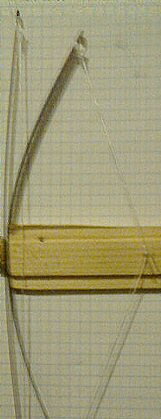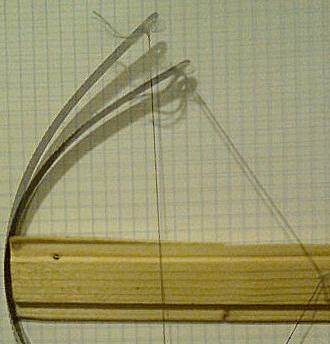There is a long discussion about crossbow efficiency on myArmory.com
http://www.myarmoury.com/talk/viewtopic.php?t=19926&postdays=0&postorder=asc&start=280
This got me thinking -
So Ralph Payne-Galway supposedly shot an antique cranequin spanned crossbow 490 yards back in 1903 or whenever it was.
Do any modern replicas approach this kind of range?

http://www.historyandcivilization.com/Battle_of_Crecy.jpg
In period illustrations crossbows are generally shown braced very high. About halfway of bolt-track.
Modern "traditional" crossbows are typically braced lower.
I did some testing with a hack-saw blade
Different brace height, same power-stroke
Notice difference in limb movement to power stroke ratio


String of high braced bow moves about four times the distance of bow tip.
Whereas low braced bow draws only twice the tip movement for same absolute string movement.
High braced bow also has shorter, thus lighter string.
Assuming same recovery rate of bow limbs, a high braced can safely cast a bolt twice as fast as bow with more
common longbow style low braceheight.
Now, weather recently has been too bad for much field testing,
but anyway an I have an old x-bow with high braced stickbow prod wich I loded with
"unhealthtly" light bolt. The cast for a few unmeasured test shots appeared very compound bow-like. Also efficiency seemed reasonable.
Test bow is pulling 57kg/135mm (125#/5,5")
Test bolt was 4grams. 7x5mm wide point ( thin nail bent to horseshoe shape around 5mm dowel )made 1cm deep hole into pine board. Suggesting maybe 15-20J kinetic energy( = ~50% efficiency).
Shooting from 20m distance did not show any observable curve in trajectory, nor much observable flight time.
So my bit unscientific preliminary testing was promising.
It seems it might be possible to build plain old-school stick bows that can rival with modern compounds.
Just something for our public to try out themselves .









 Private messages
Private messages